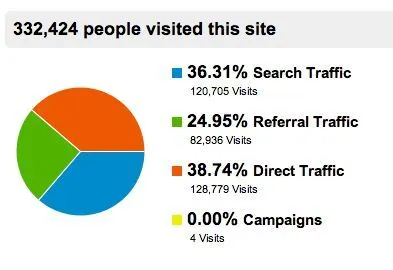Identifying your traffic sources that result in sales is imperative. You also must know the four main types of traffic sources.
To run a successful business, you need a steady stream of fresh leads. These are the people you will turn into paying customers. That’s the marketing part of the equation. To get those leads, you need traffic. You need to reach out to new people on a regular basis, and the most time and cost-effective way to do that is by generating traffic – ideally evergreen traffic from a variety of different sources.
If you want to continue to grow your business, you must consistently work on getting more traffic. And you need to measure those results. But before you can measure, you need to know just where your traffic is coming from.
This information is important for another reason. Not all sources of traffic are created equal. If you’ve run an online business – or any business, really – you want to spend as much time and resources as possible on the ones that result in paying customers. In other words, you want to increase your traffic in a way that increases your bottom line the most.
After all, a million website visitors with only four sales amounts to the same thing as a hundred visitors with four sales – four sales. More traffic doesn’t always mean more sales. You need targeted buyer traffic. First, you need to know where your current traffic is coming from and which of those sources are sending you legitimate buyers.
To do that, you must find out which source is sending the most reliable customers. You want to know who signs up for your list, thus becoming a lead. And you want to know how many of those leads convert into paying customers. You can do that by tracking your traffic, email signups, and purchases.
A great place to start is a free Google Analytics account. Make sure you have one set up, and then learn how to use the various reports. Your first stop should be Acquisition / All Traffic / Source/Medium.
Focus on one channel at a time. If you can, track each visitor as he or she moves through your autoresponder program and your shopping cart. This will tell you if it’s worth spending a lot of time interacting in a particular Facebook group, or if the person you’re hiring to create and publish multiple pins per day is worth the money you’re spending on them.
Rinse and repeat for other sources of traffic. Keep an eye on what keywords are converting well for you, and create more content around similar ones. Don’t be afraid to ask your customers how they found you. You can even make this an optional entry when someone fills out your order form. Again, the idea is to get as much data as possible, so you can analyze it and improve your top traffic sources.

Four Main Types of Traffic Sources
- Direct traffic is exactly as it sounds. It’s when someone types your domain directly into their browser, or clicks on a bookmark. If you have strong direct traffic, that means you have strong brand identity with your visitors.
- Referral traffic comes on a link from another site. This could be social media, content marketing related, or even affiliate links.
- Search traffic comes from search engines. This could be paid traffic with ads or, preferably, freely sent to your site through organic search results.
- Campaign traffic is exactly that, traffic from digital marketing campaigns. This is going to be paid traffic from Google Ads, Facebook Ads, email marketing, content marketing, etc.

Direct traffic should be around 20% of your site traffic.
These are the direct visitors. They have knowledge of your brand and chose to visit you today by directly typing your URL into their browser. Or, better yet, they bookmarked your website previously.
To make it easy for your visitors to get to you directly, select a short, easy-to-remember and easy-to-type URL and promote it abundantly. Make sure you’re using it everywhere you can, including your offline materials – letterhead, business cards, newspaper ads, wherever you have a presence offline.
Referral traffic should be providing between 20% and 30% of all visitors.
The people who link to your site are extremely valuable to your business. Make sure you know who they are and build those relationships.
How? Reach out offline or online. Comment on a blog or guest author some content for them. Link back to them in appropriate content. You can also consider your list of friends, research others who are similar who should be on that list and build relationships with them.
There’s another less obvious reason the time you spend doing this will guarantee you more referral visitors in the future. Google. The search giant puts extra trust and emphasis on the number and authority of inbound links. In short, the more referral links you have floating around the internet, the higher Google will rank your site in their results and the more traffic you’ll get.
Search traffic is within normal range at 40% to 50%.
When people first look at their analytics, they’re often surprised at how strong their search traffic is, particularly for sites with some content that have been online for a few years. Of course, increasing this traffic requires a higher-level knowledge of search engine optimization.
In addition to link building, we work to make our content as relevant as possible to searchers, and as visible as possible to Google and the other search engines. Too much dependence on search engines can be bad, however, because just as Google gives, it can also take away.
Search is a fast-moving area and change is constant. So by all means get as many visits from search as possible, but also try to diversify your visitor portfolio.
Campaign traffic is entirely up to you as the site owner.
By default, you’ll have no campaign traffic. Why would you unless you started and paid for a campaign. But campaign traffic offers you substantial opportunities to measure the effectiveness of your online marketing efforts. If you use Google Discover Ads, your campaigns will automatically show up in your Google Ads dashboard and your campaigns will display throughout the Google network, including YouTube.
While knowing where your traffic is coming from, who is supplying the most valuable traffic and exactly what the four types of website traffic are is important – it’s just the beginning.





